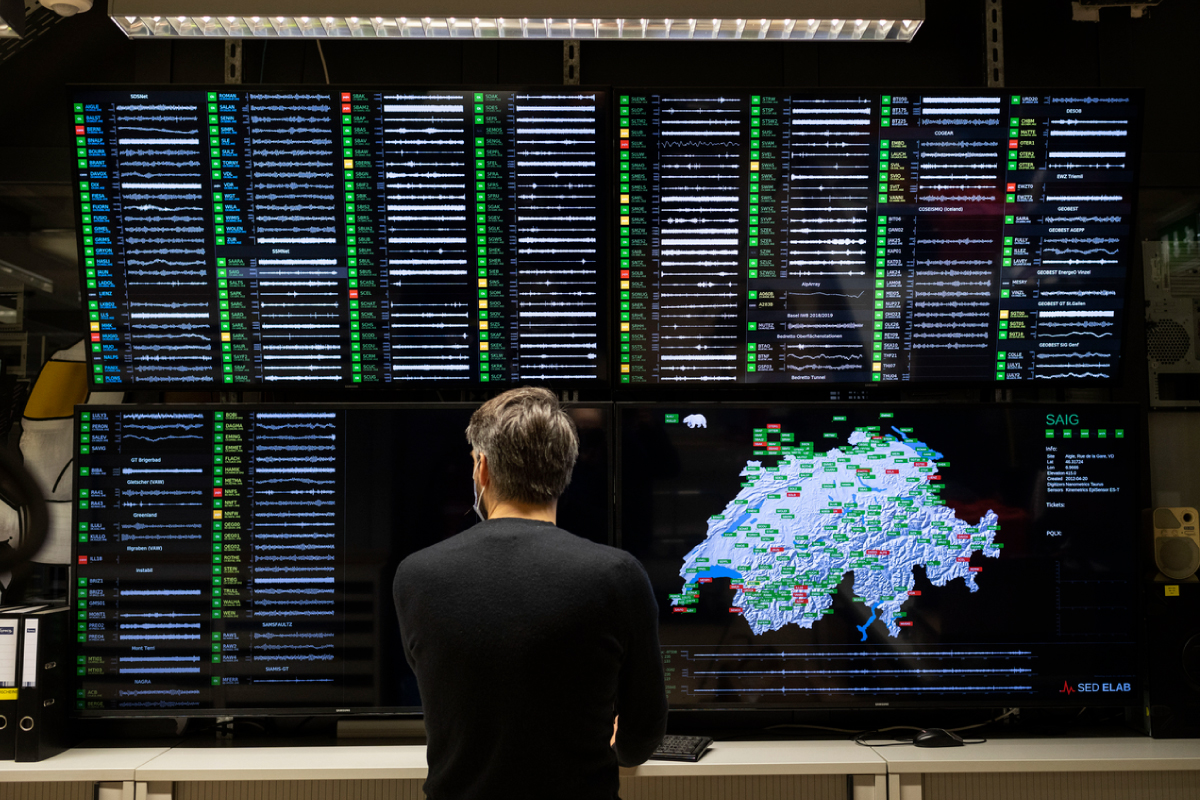Status overview of various seismic stations.

The Swiss Seismological Service (SED) monitors the seismic activity in Switzerland and its neighboring regions in real-time, using a network of over 400 stations, 300 of which are operated by the SED and 200 part of the national network. The SED-operated stations are spread all over the country and installed at various sites like caves, tunnels, and even boreholes.
Switzerland needs a seismic network to monitor background seismicity and understand the effects of rare, large-scale earthquakes that cause extensive damage. This is important even in a country with a seismic hazard as moderate as Switzerland's. A dense, state-of-the-art network that monitors seismic activity in real time fulfils this role and also rapidly notifies the authorities, the media and the public about earthquakes in the wake of significant seismic events and provide high-quality data for hazard studies and fundamental earthquake research.
Switzerland's dense seismic network consists of sophisticated, modern, low-noise stations with real-time communication to distributed processing hubs at ETH Zurich. Data are analysed and events detected within seconds after their occurrence.
The processing center in Zurich acquires data recorded in Switzerland from two different sources:
- Swiss National Network (CHNet) consisting of both the Swiss Digital Seismic Network (SDSNet) and the Swiss Strong Motion Network (SSMNet).
- Special networks (often temporary) in order to monitor increased natural seismic activity, conduct aftershock deployments, monitor geothermal exploration, support research and educational projects, or industry projects by third-party assignment.
One station with the national seismic network has a special dual purpose. The station labeled CH.DAVOX is also part of the International Monitoring System (IMS) for nuclear test ban treaty monitoring.
Instrumental monitoring of earthquake activity in Switzerland began at the onset of the 20th century (see complete history of the SED). Ever since, Switzerland has been at the forefront of seismic monitoring in Europe.
By the 1970s, a high-gain, short-period, seismic telemetry network had been installed, which recorded data on microfilm.
By the mid-1980s, the network consisted of a dense network of high-gain sensors with radio communications digitised on a central computer system with automatic processing for earthquake detection. These sensors were placed on solid rock in very-low-noise locations to enable them to record background seismicity in Switzerland.
In the late 1990s, broadband sensors fitted with 24-bit data loggers replaced the short-period sensors and GPS timing was introduced. Communications were also upgraded to a secure, high- bandwidth, internet system. In the 2000s, a limited number strong-motion sensors of similar quality began to be installed.
More recently, the national SDSNet and SSMNet networks were independently extended and refurbished. Between 2009-2024, 100 new modern strong motion sensors were installed across the country. Between 2024-2023, the SDSNet was modernised and extended to comprise around 60 backbone stations. The new, modern system combining the Swiss Digital Seismic Network (SDSNet) and the Swiss Strong Motion Network (SSMNet) is called the Swiss National Network (CHNet).
Seismic data are gathered at the SED processing hub at ETH Zurich using a standard SeedLink communication protocol. Data from strong-motion, broadband and short-period stations are all used for all data processing when appropriate. For example, provided that signal quality is sufficient, even strong-motion stations in noisy locations can help to automatically locate earthquake locations, and any on-scale seismic data can be used to produce ShakeMaps.
To ensure the robustness of the system and hedge against single hardware failures, all acquisition and processing is duplicated at two separate sites at ETH Zurich.
Waveform data are processed in real time using SeisComP, a comprehensive earthquake-monitoring platform developed at GFZ Potsdam. This software is also used for manual reviews and final earthquake catalogue management. Automatic event detection and quantification (determining seismic event location and magnitude) is usually completed within 30s of an earthquake's occurrence. Records of all seismic events are immediately published on the SED website. If the earthquake is thought to have been strong enough to be felt locally, alerts are sent to authorities, the media and relevant scientists, who review the event and establish its location manually within tens of minutes. ShakeMaps and Moment Tensors are also available for larger events. A 3D velocity model is used to improve the automatic location of seismic events and create the final earthquake catalogue.
High-rate waveform data are permanently archived in standard MiniSeed format. Event information and continuous waveform data provided by the CHNet are freely available to the community. The entire digital archive has also been converted to this format – including event-only waveforms from before 1999 and the complete, continuous archive kept since 1999. The SED is part of the European Integrated Data Archive (EIDA), and all data can be accessed via standard web services or the EIDA interactive portal link.
Swiss waveform data and earthquake information are made available in real time to neighbouring seismic networks (INGV in Italy, LED in Southern Germany, ISTerre in France, ZAMG in Austria) as well as European and global agencies (ORFEUS, GFZ, IRIS, EMSC).